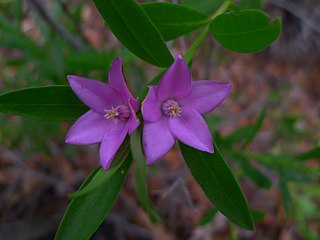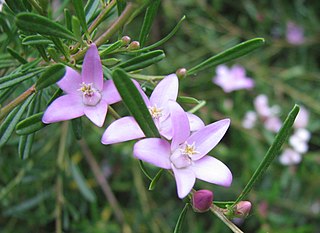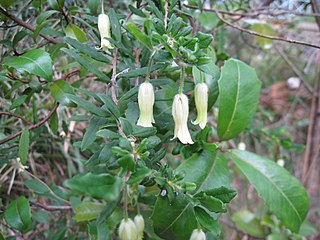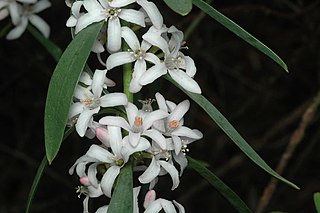
Boronia is a genus of about 160 species of flowering plants in the citrus family Rutaceae. Most are endemic to Australia with a few species in New Caledonia, which were previously placed in the genus Boronella. They occur in all Australian states but the genus is under review and a number of species are yet to be described or have the description published. Boronias are similar to familiar plants in the genera Zieria, Eriostemon and Correa but can be distinguished from them by the number of petals or stamens. Some species have a distinctive fragrance and are popular garden plants.

Darwinia, sometimes commonly known as mountain bells or simply bells, is a genus of about 70 species of evergreen shrubs in the family Myrtaceae, endemic to southeastern and southwestern Australia. The majority are native to southern Western Australia, but a few species occur in South Australia, New South Wales and Victoria. The genus was named in honour of Erasmus Darwin, grandfather of Charles Darwin by Edward Rudge in 1816. Most darwinias grow to a height of between 0.2 and 3 m, and many are prostrate shrubs. Most have small, simple leaves and the flowers are often grouped together, each flower with five red, white or greenish petals and ten stamens. In many species, the flowers are surrounded by large, colourful bracts, giving rise to their common names.

Geijera is a genus of shrubs and trees in the family Rutaceae and are native to New Guinea, Australia and New Caledonia. They have simple leaves arranged alternately, panicles of bisexual flowers usually with five, sometimes four, sepals, petals and stamens and fruit containing shiny black seeds.

Crowea saligna, commonly known as willow-leaved crowea, is a plant in the rue family, Rutaceae and is endemic to eastern New South Wales in Australia. It is a small shrub with attractive, pink, star-shaped flowers and is commonly cultivated.

Hakea salicifolia commonly known as the willow-leaved hakea, is species of flowering plant that is endemic to eastern Australia. It is an adaptable, fast growing small tree or shrub with attractive foliage and cream white flowers.

Crowea exalata, commonly known as small crowea or waxflower, is a flowering plant in the family Rutaceae and is endemic to the states of Queensland, New South Wales and Victoria in Australia. It is an attractive small shrub and is a popular garden plant. It flowers mainly from late summer to mid-winter when few others are flowering but usually has some flowers at other times of the year.

Billardiera scandens, commonly known as apple berry or apple dumpling, is a small shrub or twining plant of the Pittosporaceae family which occurs in forests in the coastal and tableland areas of all states and territories in Australia, apart from the Northern Territory and Western Australia. It has a silky touch and appearance that becomes more brittle as the dense growth matures. The inflorescence consists of single or paired yellow flowers, pink-tinged yellow sepals and bright yellow petals and is attached to a hairy drooping peduncle. The summer flush produces fruit of oblong berries up to 30 mm long, initially green in colour and covered in fine hair - somewhat akin to a tiny kiwifruit in appearance.

Phebalium stenophyllum, commonly known as narrow-leaved phebalium, is a species of small shrub that is endemic to south-eastern Australia. It has scaly branchlets, narrow oblong to more or less cylindrical leaves and yellow flowers in umbels of three to ten.

Phebalium nottii, commonly known as pink phebalium, is a species of shrub that is endemic to eastern Australia. It has branchlets with silvery scales, oblong to elliptical leaves, deep pink to mauve flowers arranged in umbels of up to six, with the stamens distinctively offset to one side of the flower.

Philotheca salsolifolia is a species of flowering plant in the family Rutaceae and is endemic to New South Wales and the Australian Capital Territory. It is a shrub with crowded, more or less cylindrical leaves and pink to mauve flowers with a dark central stripe and arranged singly or in twos or threes on the ends of branchlets.

Androcalva fraseri, commonly known as blackfellow's hemp or brush kurrajong, is a species of flowering plant in the family Malvaceae and is endemic to eastern Australia. It is a small tree or shrub that forms suckers and has egg-shaped or lance-shaped leaves with serrated edges, and clusters of 13 to 21 white flowers.

Ehretia saligna, commonly known as peach bush, native willow and peachwood is a species of shrubs or small trees, endemic to Northern Australia. The natural range extends from the Gascoyne, across the Northern Territory throughout northern Queensland and coastal; regions of Southern Queensland and New South Wales.

Crowea angustifolia is a flowering plant in the family Rutaceae, and is endemic to the south-west of Western Australia. It is an erect shrub growing to 3 m (10 ft) high by 1.0 m (3 ft) in diameter with white or pink flowers in spring.

Melaleuca salicina, commonly known as willow bottlebrush, is a plant in the myrtle family Myrtaceae, and is endemic to eastern Australia. Some Australian state herbaria continue to use the name Callistemon salignus, a name that is accepted by the Australian Plant Census. It is a shrub or small tree with soft foliage, pink new growth, white papery bark and spikes of usually white or creamy bottlebrush flowers in spring.

Philotheca angustifolia, commonly known as narrow-leaf wax flower, is a species of flowering plant in the family Rutaceae and is endemic to south-eastern Australia. It is a shrub with small leaves and white flowers with five egg-shaped petals in spring.
Leionema sympetalum, commonly known as Rylstone bell, is a shrub with greenish-yellow tubular flowers in small terminal clusters at the end of smooth, angular branches. It has a restricted distribution, grows near Rylstone in New South Wales.

Leionema viridiflorum commonly known as green phebalium, is a species of flowering plant in the family Rutaceae. It is a small shrub with pale yellow-greenish flowers in clusters at the end of branches from winter to early spring. It has a restricted distribution in northern New South Wales.

Philotheca conduplicata is a species of flowering plant in the family Rutaceae and is endemic to eastern Australia. It is a shrub with elliptical leaves clustered near the ends of the branchlets and white flowers arranged singly or in two or threes on the ends of the branchlets.

Philotheca epilosa is a species of flowering plant in the family Rutaceae and is endemic to eastern Australia. It is a shrub with egg-shaped to lance-shaped leaves with the narrower end toward the base and crowded near the ends of the glandular-warty branchlets, and white flowers usually arranged singly on the ends of the branchlets.

Philotheca scabra is a species of flowering plant in the family Rutaceae and is endemic to New South Wales. It is a small shrub with variably shaped leaves, depending on subspecies, and single white to pink flowers arranged on the ends of branchlets.



















